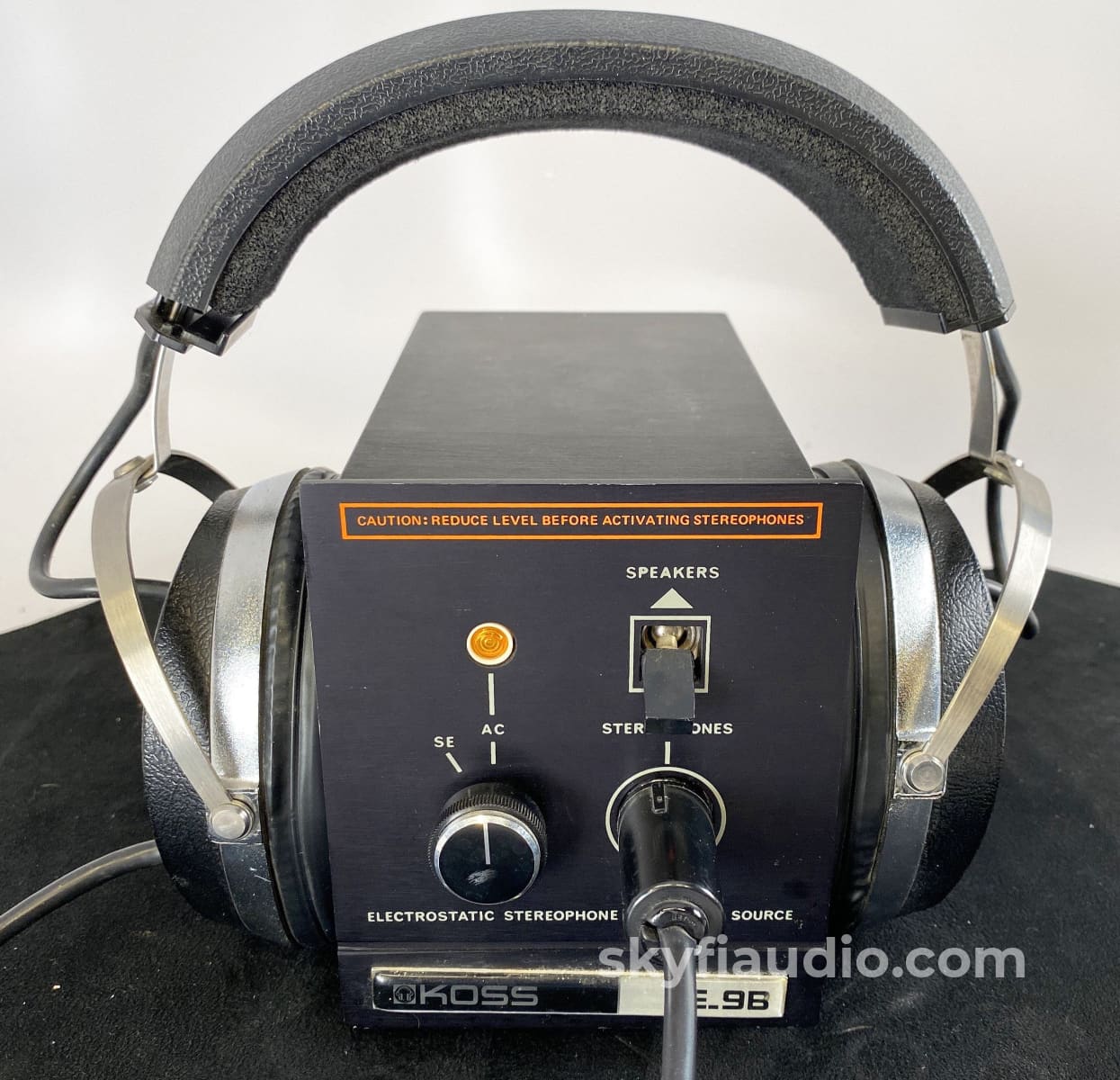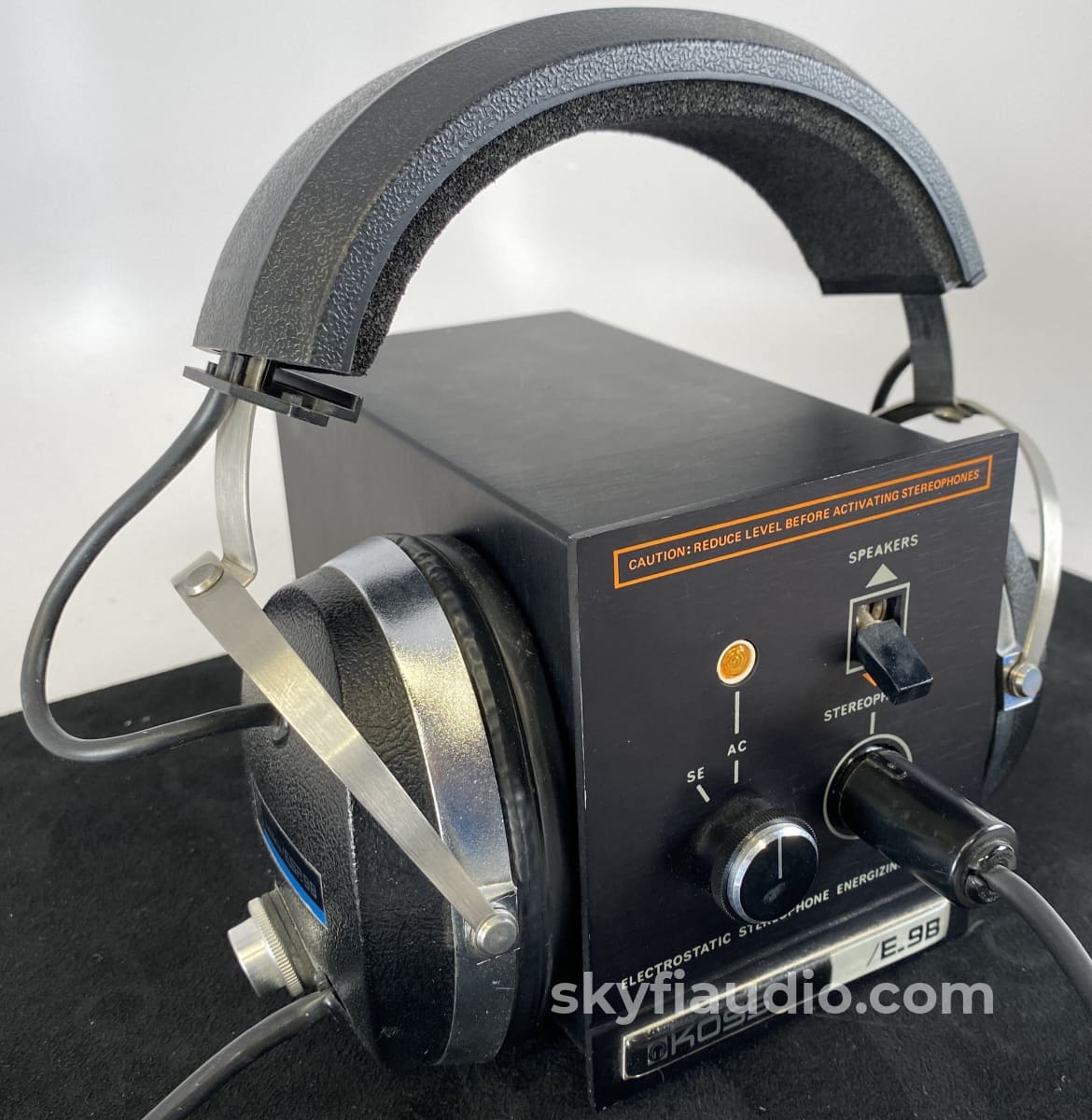







Koss Vintage Studio Monitor/ESP.9B Electrostatic Headphones + E/9B Energizer + New Pads
Free Shipping on Most Electronics - Excludes Speakers and Items Requiring Freight - Contiguous U.S. Only
Pickup currently unavailable at SkyFi 479

Koss Vintage Studio Monitor/ESP.9B Electrostatic Headphones + E/9B Energizer + New Pads
SkyFi 479
479 South Broad Street
Glen Rock NJ 07452
United States
This listing includes pieces as pictured:
1) Koss Studio Monitor/ESP.9B Electrostatic Stereophones
2) Koss Model E/9B Electrostatic Stereophone Energizer
Specifications:
• AC - or signal-powered electrostatic
• Impedance: 4 to 16 ohms
• Max input signal: 12W continuous program
• Headset weight: 19 oz. Cord length: 5½
• Price: $150 (1973) = $875 in today's dollars
• Manufacturer: Koss Corporation, 4129 N. Port Washington Road, Milwaukee, WI.
From an April 1973 Sterephile article written by J. Gordon Holt:
The top-of-the-line model from America's leading headphone manufacturer, these are bulky, heavy, very business-like in appearance, and very, very good.
The ESP-9 is dual-powered: from the AC line, or from the input signal itself, The power supply is rather large and heavy, and appropriate in appearance to the phones. Amplifier connections are via wires with spade lugs attached, and speaker connections are made to the rear of the power supply. A front-panel switch selects speaker or headphone operation, and terminates the amplifier outputs with 10 ohms in the Phones position.
Construction is typically top-of-the-line Koss: Rugged, nicely finished, and apparently very durable, and the phones are easy to handle. (Many headphones are so loosely pivoted on their headbands that they swing into impossible positions whenever you pick them up.)
The ESP-9s have very effective rejection of outside sounds, which makes them ideal for monitoring on-location live-recording sessions. They are however quite heavy, and exert considerable pressure on the head (which is one reason for their unusually good noise-rejection characteristics), with the result that they may cause vague feelings of claustrophobia in some listeners.
The 5½' cable is rather stiff and a bit awkward to handle, and the length was judged barely adequate to provide freedom of movement. A 9' extension for the phones-to-supply cable is available (at unspecified but presumably nominal cost), but its use causes a noticeable attenuation of high-frequency response (estimated at 3dB loss at 10kHz). However, since most samples of the ESP-9s sound just a shade ug at the high end and a shade down when using the 9' extension, this raises the possibility of getting perfectly flat response from them by using half the length of the extension (by cutting it and reconnecting one plug to the shortened end). We did not investigate this further, but see no reason why it would not work. There would be a loss of output at frequencies above about 12kHz, but the phones' extraordinary performance throughout the entire rest of the audio range is worth far more than a small loss at the extreme top.
Listening
There was, of course, the incredible detail, snap, and transparency that we have come to expect from electrostatic transducers in general and electrostatic headphones in particular, but there were few of the little flaws which have made most other electrostatic phones somewhat less than perfect reproducers. The ESP-9s are almost perfectly neutral in sound, being neither brilliant nor subdued. The pair we conducted most of our tests on were chosen at random from a dealer's stock, after we had had the opportunity to listen briefly to several other samples. Some of those were a shade smoother at the high end than our main test sample, but all were judged smoother than any other electrostatic headset we had ever tested.
Koss supplies frequency response curves for each pair of ESP-9s, and we found that—at least at the high end—these curves looked exactly the way the phones sounded (fig.1), which is a tribute to the accuracy and validity of Koss's test procedures. All ESP-9s have a very slight dip in the response from about 4–9kHz and a rise back to normal from 10kHz on out to 15 or 18kHz, which is the range where the greatest differences between different samples were noted.

Our main test sample, for instance, rose to about 1½dB higher level at 12kHz than some others, and thus sounded very subtly "zizzy" on high percussion and string tone. And this could have been predicted from the curves supplied with the phones. There was not however any audible effect on tape hiss, disc surface noise or mis-tracking distortion.
Since headphone response curves are normally run on a special testing jig that provides an airtight seal between the phones and the test-probe mike, a manufacturer's rating of low-frequency response is usually extremely optimistic, to put it charitably. Koss claims a fantastic 10Hz low-end range for the ESP-9, but since the phones can never form as airtight a seal against one's ears as against the test jig, air leakage will usually cause a marked attenuation of actual bass performance. Despite this, we found the ESP-9s to provide subjectively flat response down to a remarkable 35Hz, with usable response down to an incredible 25Hz! There was no indication of response peaking anywhere in the low-end range, and bass was in fact about as clean and detailed as we have ever heard from any transducer. Some low-end muddiness was audible on some program material, but in every case, this proved to be in the signal and not a result of the phones.
All in all, the effect of listening to the ESP-9s was almost like that of listening right through to the original sounds. Some graininess was observed on some program material, but again, this proved to be a function of the recording or the associated equipment rather than of the phones. In fact, we were more acutely aware of subtle differences in amplifiers and preamps when listening through the ESP-9s than we have ever noticed when listening to any speaker system.
Issues
The ESP-9s were rather inefficient—substantially less so than most dynamics—and must be driven from a power amplifier. With adequate power, they will put out very high levels without stress, but since the manufacturer recommends a marimum of 12 watts of program input, we would not advise trying to reproduce hard rock levels from them. We did overload ours on occasion when using a dual 60W amplifier, and no harm was done to them, but we don't recommend that as S.O.P. There's no mistaking an overload, though; the overtaxed phone emits an ear-shattering click and drops by a few dB in level until the polarizing charge builds up again. Bad for your ears, if not for the phones.
The signal-powered feature is, so far as we know, unique to Koss's electrostatic phones, and it works, if not terribly well. When the second front-panel switch is set to SP, a small amount of the input signal is drawn off from the high-voltage seccondary winding of the input transformers, and rectified into DC. This is fed through isolating resistors to the headphone diaphragms, where it builds up the static charge necessary to make the phones operate. As we said, it does work, and it allows you to listen to the output from any power amplifier even when there is no available source of 115V AC, as in an automobile.
However, the phones do operate at less than maximum efficiency in the signal-powered mode, and in fact their efficiency varies rather widely from one moment to the next, depending on the average volume of the signal. With consistently loud material at high listening level, signal-powered efficiency is only slightly less than with AC powering. With wide-dynamic-range material containing fairly long periods of quiet program, efficiency is noticeable lower, and falls to a very low level after several minutes of soft music. In other words, the self-powering does an adequate job with some program material, and is nice when no AC is available, but best results are obtained with the regular AC powering.
Conclusion
Summing up, then, we feel that, at least within the limitations of headphone listening per se, these are the best sound reproducers we have ever encountered, and do not hesitate to recommend them to anyone who demands the best possible sound and the maximum rejection of outside noises, either for private listening at home or for evaluating the sound of on-location recording pickups. We bought a pair of them, and have found no reason to regret having done so.
Please click here for detailed specifics regarding our specialized packing process that separates us from the rest.
|
Item |
Included |
|
Original Box |
No |
|
Manual |
No |
|
Remote |
N/A |
|
Cables |
As Pictured |
|
Physical Condition |
7 |
|
Working Condition |
10 |
Choose options
